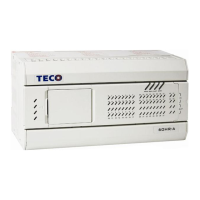
Do you have a question about the TECO TP03 PLC and is the answer not in the manual?
| Brand | TECO |
|---|---|
| Model | TP03 PLC |
| Category | Controller |
| Language | English |
Explains how to interpret the model numbers for basic and expansion units.
Lists and categorizes various basic, expansion, communication modules, and programming tools.
Illustrates how basic and expansion units connect to form a system.
Details the pin definition and internal connection of the OP07/08-TP03 cable.
Details the pin definition and internal connection of the TP03-302PC cable.
Explains the PC/PDA port connection to HMI using RS-422, including pin assignments.
Shows the terminal block layout for various TP03 basic units.
Details the core functions, general specifications, power supply, features, and environmental requirements of the basic TP03 unit.
Describes the electrical specifications and wiring for digital inputs and outputs.
Details the location, function, and settings for the three communication ports.
Explains characteristics, number of counters, functions, and application examples.
Details how to configure inputs for interruption and the associated pointer assignments.
Specifies pulse output capabilities, PWM output, frequency, and application instructions.
Explains the availability and installation of expansion cards for the basic unit.
Describes the types of memory, saving content, and saving places for built-in and external memory.
Explains how to set passwords for program protection and their different levels.
Details the three modes for controlling the PLC's RUN/STOP state.
Covers the Real-Time Clock specifications, special application instructions, and setting the time.
Explains the built-in analog potentiometers and their use for setting values.
Provides specifications for the battery, its usage, and handling precautions.
Refers to Chapter 7 for instruction set details.
Covers general specifications, outline dimensions, and electrical specifications for digital expansion units.
Introduces analog expansion units, their system configuration, and data registers.
Explains limitations on connecting expansion units based on base unit type and power consumption.
Provides dimensional drawings for the basic TP03 units.
Guides the user through the installation process, including ambient environment and mounting methods.
Provides general guidelines for wiring, including torsion torque and wire routing.
Details power supply wiring for AC and DC types, including terminal connections and precautions.
Shows input and output wiring diagrams for various expansion units.
Provides guidelines for input power, input signals, and output terminals to ensure correct operation.
Offers solutions for noise reduction, including grounding, power source noise, and thunder stroke protection.
Outlines checks to perform before powering on the PLC and its wiring.
Details periodic inspection items for basic units and expansion units to ensure optimal operation.
Guides users through diagnosing and resolving errors based on LED indicators and specific procedures.
Explains fundamental logical operations like Load, AND, OR, and their variations.
Describes the Step Ladder ([STL]) and Step Ladder Return ([RET]) instructions.
Lists various application instructions categorized by function.
Details special relays related to PC status, including RUN monitor and error flags.
Lists special relays for clock functions like period oscillators and time setting.
Describes operation flags related to zero, borrow, carry, and program execution.
Lists special data registers for PC status, version, and error codes.
Details special data registers for Real-Time Clock functions like scan times and date/time components.
Covers special relays for controlling PC operation modes and register clear functions.
Specifies data registers for constant scan mode settings.
Lists special relays for controlling Step Ladder execution and annunciator functions.
Details data registers used for Step Ladder ON state addressing.
Describes special relays for enabling or disabling input and timing interruptions.
Lists special relays used to set the UP/DOWN counting modes for counters.
Lists special relays related to expansion card errors, hardware checks, and communication errors.
Lists special data registers for error codes related to various functions.
Details special relays for RS485 communication port status and MBUS instructions.
Specifies data registers for RS485 and expansion communication port settings.
Lists special relays related to RMIO communication and expansion port status.
Specifies data registers for DTLK communication parameters.
Covers special relays for high-speed counter zone compare, speed detection, and pulse output status.
Details data registers for PWM time base settings.
Lists special relays for processing modes like SWAP and HEX data processing.
Specifies data registers related to high-speed counter zone compare and pulse output values.
Lists special relays corresponding to OP07/08 keypad functions (F1-F12, Up/Down, Left/Right, TMR, CNT, ENT, MOD, ESC).
Details data registers for OP07/08 display content, mode settings, and data formats.
Lists special relays for setting AD/DA module modes and error detection.
Specifies data registers for setting AD/DA channel modes and for reading/writing AD/DA data.